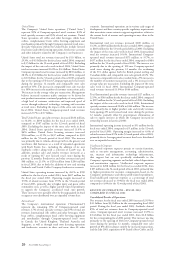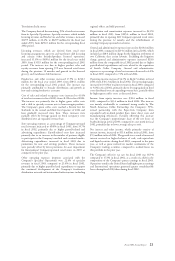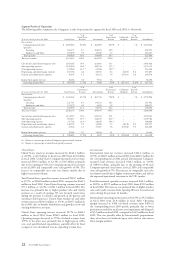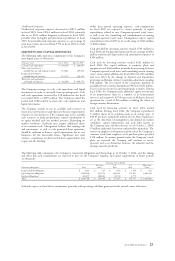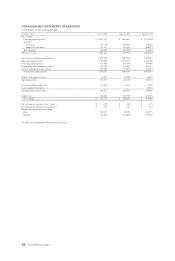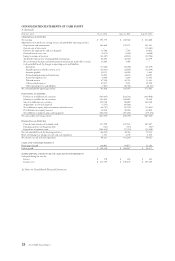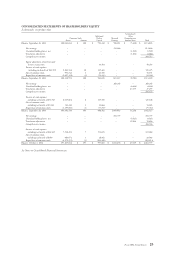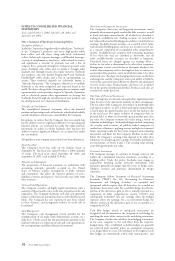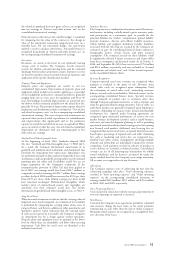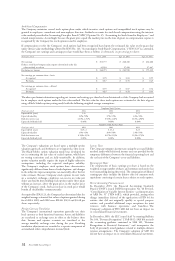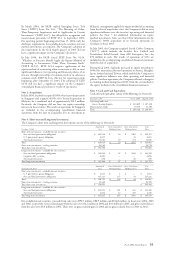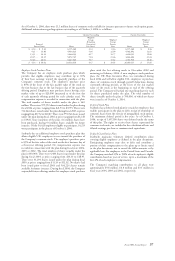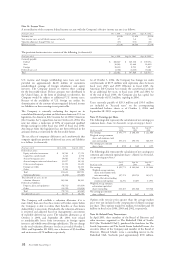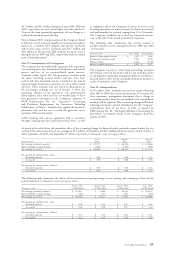Starbucks 2004 Annual Report Download - page 19
Download and view the complete annual report
Please find page 19 of the 2004 Starbucks annual report below. You can navigate through the pages in the report by either clicking on the pages listed below, or by using the keyword search tool below to find specific information within the annual report.30 Fiscal 2004 Annual Report
NOTES TO CONSOLIDATED FINANCIAL
STATEMENTS
Years ended October 3, 2004, September 28, 2003, and
September 29, 2002
Note 1: Summary of Signifi cant Accounting Policies
Description of Business
Starbucks Corporation (together with its subsidiaries, “Starbucks”
or the “Company”) purchases and roasts high-quality whole
bean coffees and sells them, along with fresh, rich-brewed
coffees, Italian-style espresso beverages, cold blended beverages,
a variety of complementary food items, coffee-related accessories
and equipment, a selection of premium teas and a line of
compact discs, primarily through its Company-operated retail
stores. Starbucks sells coffee and tea products through other
channels and, through certain of its equity investees, Starbucks
also produces and sells bottled Frappuccino® and Starbucks
DoubleShot® coffee drinks and a line of superpremium ice
creams. These nonretail channels are collectively known as
“Specialty Operations.” The Company’s objective is to establish
Starbucks as the most recognized and respected brand in the
world. To achieve this goal, the Company plans to continue rapid
expansion of its retail operations, to grow its Specialty Operations
and to selectively pursue other opportunities to leverage the
Starbucks brand through the introduction of new products and
the development of new channels of distribution.
Principles of Consolidation
The consolidated fi nancial statements refl ect the fi nancial
position and operating results of Starbucks, which include wholly
owned subsidiaries and investees controlled by the Company.
Investments in entities that the Company does not control, but
has the ability to exercise signifi cant infl uence over operating and
fi nancial policies, are accounted for under the equity method.
Investments in entities in which Starbucks does not have the
ability to exercise signifi cant infl uence are accounted for under
the cost method.
All signifi cant intercompany transactions have been eliminated.
Fiscal Year End
The Company’s fi scal year ends on the Sunday closest to
September 30. The fi scal year ended October 3, 2004, included
53 weeks. The fi scal years ended September 28, 2003, and
September 29, 2002, each included 52 weeks.
Estimates and Assumptions
The preparation of fi nancial statements in conformity with
accounting principles generally accepted in the United
States of America requires management to make estimates
and assumptions that affect the reported amounts of assets,
liabilities, revenues and expenses. Actual results may differ from
these estimates.
Cash and Cash Equivalents
The Company considers all highly liquid instruments with a
maturity of three months or less at the time of purchase to be cash
equivalents. The Company maintains cash and cash equivalent
balances with fi nancial institutions that exceed federally insured
limits. The Company has not experienced any losses related
to these balances, and management believes its credit risk to
be minimal.
Cash Management
The Company’s cash management system provides for the
reimbursement of all major bank disbursement accounts on a
daily basis. Checks issued but not presented for payment to the
bank are refl ected as a reduction of cash and cash equivalents on
the accompanying consolidated fi nancial statements.
Short-term and Long-term Investments
The Company’s short-term and long-term investments consist
primarily of investment-grade marketable debt securities, as well
as bond and equity mutual funds, all of which are classifi ed as
trading or available-for-sale. Trading securities are recorded at
fair value with unrealized holding gains and losses included in net
earnings. Available-for-sale securities are recorded at fair value,
and unrealized holding gains and losses are recorded, net of tax,
as a separate component of accumulated other comprehensive
income. Available-for-sale securities with remaining maturities
of less than one year are classifi ed as short-term, and all
other available-for-sale securities are classifi ed as long-term.
Unrealized losses are charged against net earnings when a
decline in fair value is determined to be other than temporary.
Management reviews several factors to determine whether a loss
is other than temporary, such as the length of time a security is in
an unrealized loss position, extent to which fair value is less than
amortized cost, the impact of changing interest rates in the short
and long term and the Company’s intent and ability to hold the
security for a period of time suffi cient to allow for any anticipated
recovery in fair value. Realized gains and losses are accounted
for on the specifi c identifi cation method. Purchases and sales are
recorded on a trade date basis.
Fair Value of Financial Instruments
The carrying value of cash and cash equivalents approximates fair
value because of the short-term maturity of those instruments.
The fair value of the Company’s investments in marketable debt
and equity securities, as well as bond and equity mutual funds,
is based upon the quoted market price on the last business day
of the fi scal year. For equity securities of companies that are
privately held, or where an observable quoted market price does
not exist, the Company estimates fair value using a variety of
valuation methodologies. Such methodologies include comparing
the security with securities of publicly traded companies in
similar lines of business, applying revenue multiples to estimated
future operating results for the private company and estimating
discounted cash fl ows for that company. Declines in fair value
below the Company’s carrying value deemed to be other than
temporary are charged against earnings. For further information
on investments, see Notes 4 and 7. The carrying value of long-
term debt approximates fair value.
Derivative Instruments
The Company manages its exposure to foreign currency risk
within the consolidated fi nancial statements according to a
hedging policy. Under the policy, Starbucks may engage in
transactions involving various derivative instruments with
maturities generally not longer than fi ve years, to hedge assets,
liabilities, revenues and purchases denominated in foreign
currencies.
The Company follows Statement of Financial Accounting
Standards (“SFAS”) No. 133, “Accounting for Derivative
Instruments and Hedging Activities,” as amended and
interpreted, which requires that all derivatives be recorded on
the balance sheet at fair value. For a cash fl ow hedge, the effective
portion of the derivative’s gain or loss is initially reported as a
component of other comprehensive income (“OCI”) and
subsequently reclassifi ed into net earnings when the hedged
exposure affects net earnings. For a net investment hedge, the
effective portion of the derivative’s gain or loss is reported as a
component of OCI.
Cash fl ow hedges related to anticipated transactions are
designated and documented at the inception of each hedge by
matching the terms of the contract to the underlying transaction.
The Company classifi es the cash fl ows from hedging transactions
in the same categories as the cash fl ows from the respective
hedged items. Once established, cash fl ow hedges are generally
not removed until maturity unless an anticipated transaction
is no longer likely to occur. Discontinued or derecognized cash
fl ow hedges are immediately settled with counterparties, and


